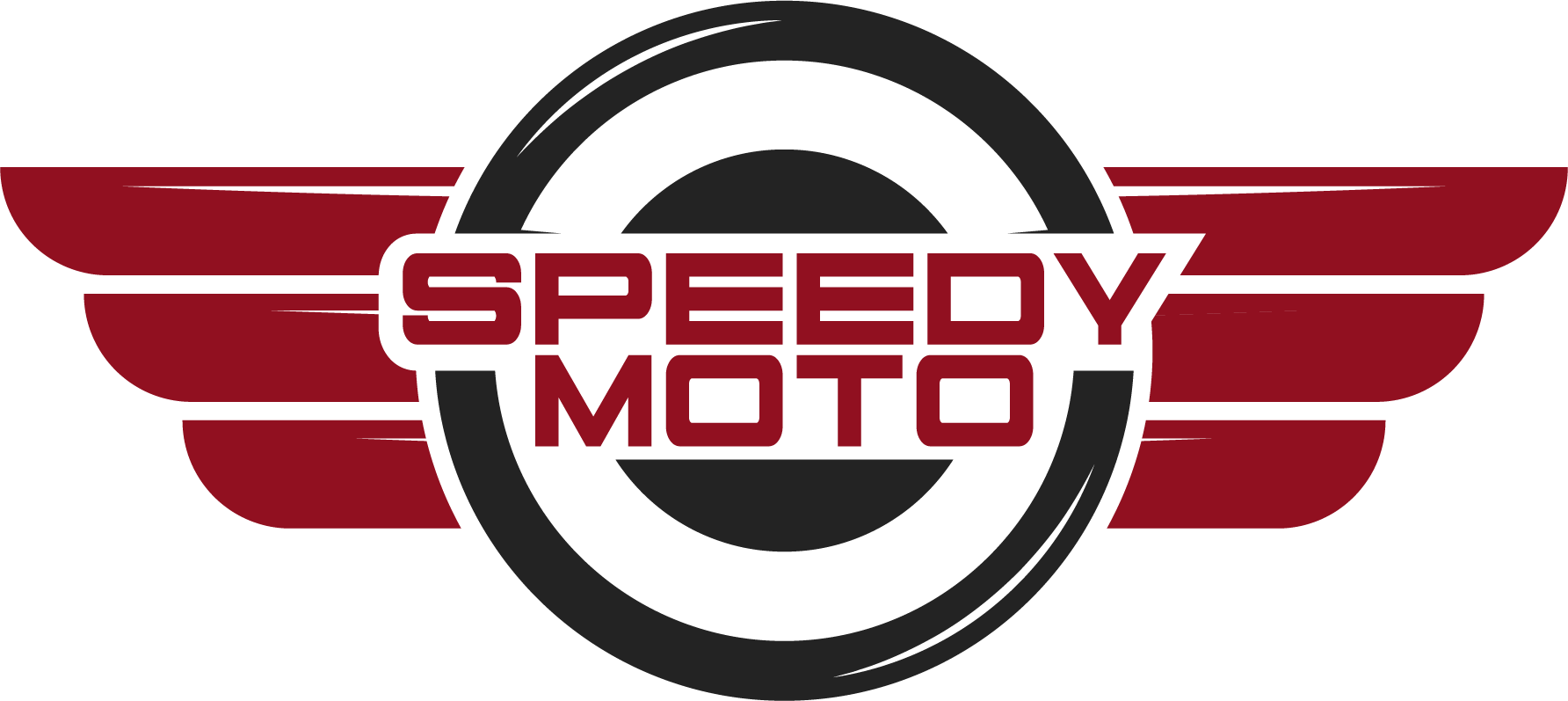Speedy Moto is reader-supported. When you buy through links on our site, we may earn an affiliate commission.
A motorcycle helmet is the most important piece of riding gear. There are a lot of options to choose from, and it’s important to know what specifications to look for to find the right one for you.
We’re going to examine everything you need to know about choosing a helmet. Then, we'll show you our top picks to help make the decision a little easier.
At a Glance: Our Top Picks for Best Motorcycle Helmets
- OUR TOP PICK: Scorpion EXO-R2000
- RUNNER-UP: Arai XD4
- BEST BUDGET OPTION: Bell Qualifier DLX
Comparison of the Best Motorcycle Helmets
| IMAGE | PRODUCT | |
|---|---|---|
Our Top Pick  |
| View Latest Price → |
 |
| View Latest Price → |
Best Budget Option  |
| View Latest Price → |
 |
| View Latest Price → |
 |
| View Latest Price → |
 |
| View Latest Price → |
 |
| View Latest Price → |
What Are the Components of a Motorcycle Helmet?
Motorcycle helmets have four components. They are:
The Outer Shell
The outer shell is the part of the helmet that’s visible. Its main purpose is to withstand the initial impact in an accident, even if it is cracked and destroyed as a result.
Interior Lining
Interior lining absorbs and disperses the energy from impact so that less of it reaches the rider’s head.
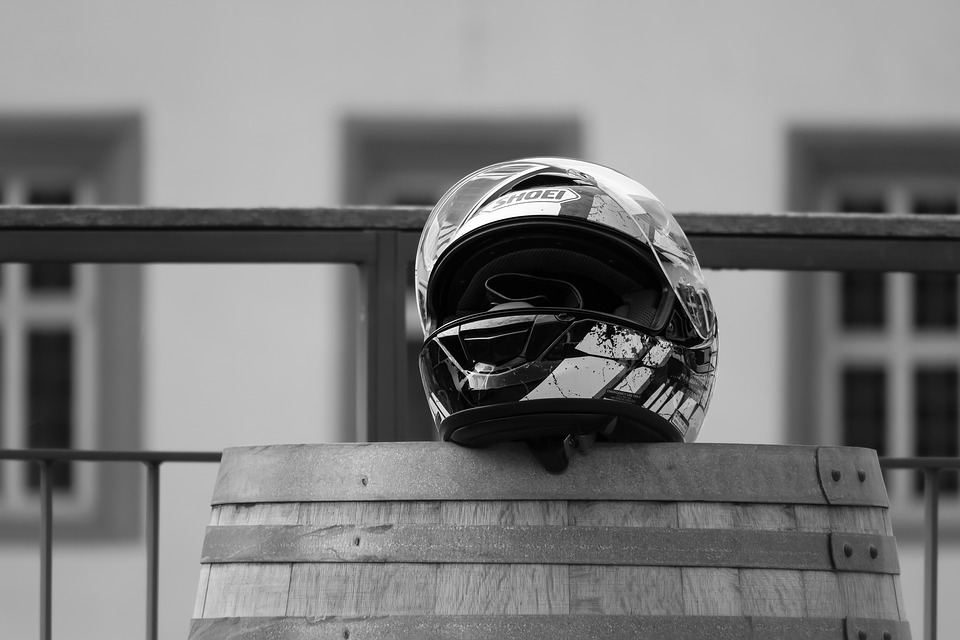
Foam Lining
The foam lining sits between the interior lining and the rider’s head. Its main purposes are to provide comfort and make sure the helmet fits the head properly.
Chinstrap
This vital component keeps the helmet in place if there’s an accident. No matter how good the rest of the helmet is, it won’t be effective without a chin strap to hold it in place.
What Are Motorcycle Helmets Made of?
Since each component serves a different purpose, they are made of different materials. The outer shell is usually composed of fiberglass, Kevlar, carbon fibers, or plastic. The interior lining is commonly comprised of Styrofoam. Woven nylon makes up the chin straps.
How to Choose a Motorcycle Helmet
Research is essential when choosing a motorcycle helmet. Safety is the primary factor. Never choose a motorcycle helmet based on price. Here are some things to contemplate when determining the right helmet for you:
Comfort and Fit
Safety is of primary importance, and proper fit is required for the helmet to be safe. Comfort is also important as helmets are often worn for extensive periods of time. Helmets should have a snug but comfortable fit.
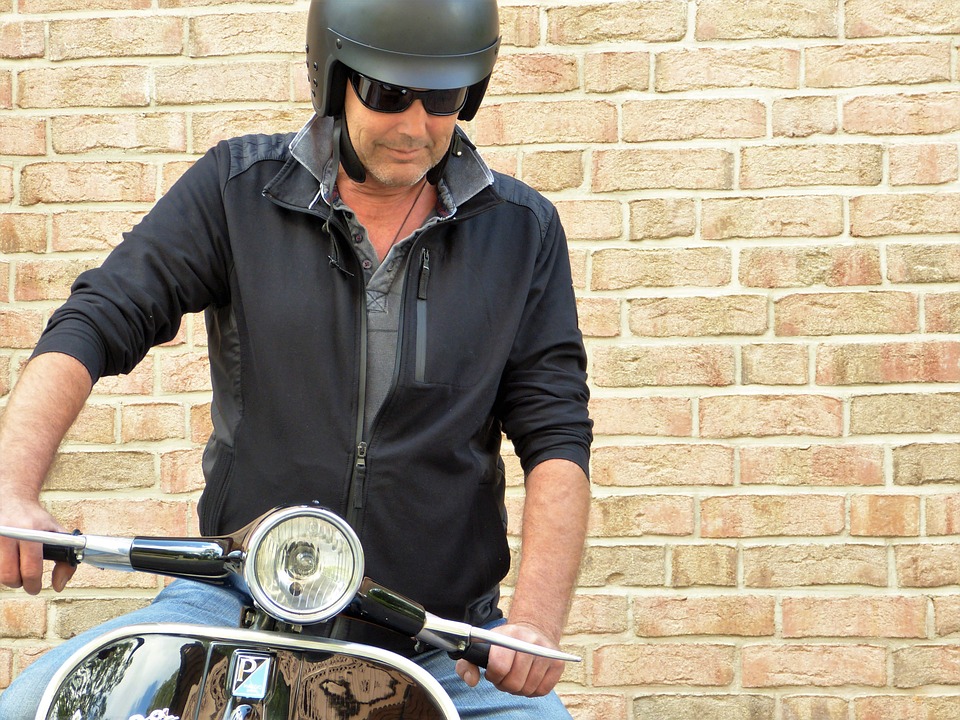
Ventilation
Ventilation is an essential component to staying cool and comfortable. If a helmet is comfortable, the rider is more likely to keep their helmet on for the duration of the ride. Air should be able to pass through, lowering the temperature and keeping the rider sweat-free.
Visibility
An unobstructed view is one of the most important parts of staying safe while riding. The helmet should provide a clear view of everything in front of you, and peripheral vision should be unobstructed. Some helmets also have shields to protect you from inclement weather and insects.
What Kind of Motorcycle Helmet Should I Get?
While price should never be the first thing you consider, it is always going to be a factor in what helmet you choose. Your goal is to get the most value for your money. That said, finding the best helmet for the best price requires investing a lot of time and effort.
Review of the Best Motorcycle Helmets
Now, let's take a look at some of the best motorcycle helmets available and how they perform better than their competitors.
Best Overall:
Scorpion EXO-R2000

PROS
CONS
Helmet Specs
- Type of Helmet: Racing
- Materials Used: TCT Composite Shell consisting of a proprietary five-layer blend of fiberglass, Aramid, and organic poly-resin fibers
- Brand: Scorpion
- Type: Full face
- Certifications: Snell 2010, DOT
- Clasp type: Titanium double D-ring
- Weight: 3.54 lbs
What Types of Activities is the Scorpion EXO-R2000 Best For?
This helmet was made for racing, tested in the lab and on the track, and designed with input from MotoGP riders. It has two face shields, clear and dark smoke grey, so the rider can change it according to race day conditions.
Safety Features of Scorpion EXO-R2000
The emergency release system uses simple tabs under the neck. This allows for the quick and safe removal of the helmet.
The outer shell is a TCT composite developed by Scorpion. It uses a blend of fiberglass, organic poly-resin fibers, and Aramid.
What Are the Components of the Scorpion EXO-R2000?
Vents and ports. The EXO-R2000 has six intake ports and 10 exhaust vents to let cool air in and warm air out efficiently.
Moisture-wicking cheek pads and liner. These are breathable to help with temperature control and can be removed and cleaned.
Adjustable AirFit cheek pads. Thanks to this technology, the rider can adjust the cheek pads to get a precise fit.
Runner Up:
Arai XD4

PROS
CONS
Helmet Specs
- Type of Helmet: Cruiser, Touring, Street bike
- Materials Used: Super CLC shell made of carbon fiber, fiberglass, and resins
- Brand: Arai
- Type: Full face
- Certifications: DOT, ECE, Snell M2020
- Clasp type: Double D-ring
- Weight: 3.66 lbs
What Types of Activities is the Arai XD4 Best For?
The Arai XD4 is good for street bikes and cruising, but it's popular with ADV enthusiasts, too. It’s versatile as you can change the configuration depending on how you want to ride. Use the shield and peak for dual-sport or remove it for highway riding.
Safety Features of Arai XD4
The emergency cheek pad release system allows easier access to an injured rider. Emergency medical professionals can use the integrated pull tabs to remove the helmet.
This helmet is Snell certified, which is tougher to get than other certifications. They test for impact and penetration beyond what the law mandates.
What Are the Components of the Arai XD4?
Vents and ports. This helmet is extremely well-ventilated with top diffuser ports, exhaust ports, side cowl vents, brow vents, and chin vents with intake ports.
Adjustable cheek pad system. The comfort liner and cheek pads with 5mm peel-away custom layer let the rider tailor the fit.
Dry-cool technology. The interior keeps the rider comfortable for the long haul. The padding is removable, washable, and replaceable.
Best for the Money:
Bell Qualifier DLX

PROS
CONS
Helmet Specs
- Type of Helmet: Powersport
- Materials Used: Lightweight polycarbonate
- Brand: Bell
- Type: Full face
- Certifications: DOT and ECE
- Clasp type: D-ring
- Weight: 3.34 lbs
What Types of Activities is the Bell Qualifier DLX Best For?
The Qualifier DLX is an ideal street riding helmet. The full-face coverage and lightweight design are suitable for highway riding. This helmet is good at high speeds and long distances.
Safety Features of Bell Qualifier DLX
The aerodynamic design prevents buffeting and lift. This gives less resistance to increased concentration.
It includes clear and dark smoke anti-fog, anti-scratch shields with UV protection. The ClickRelease system lets you change shields without any tools.
What Are the Components of the Bell Qualifier DLX?
Adjustable ventilation system. Four exhaust ports on the back of the helmet and optional front vents provide fast cooling.
Removable, washable pads. The contoured cheeks pads are extremely comfortable and easy to clean.
Face shields. Clear and dark smoke face shield are included as well as a breath deflector for clear visibility.
Best Motorcycle Half Helmet:
Bell Pit Boss Helmet

PROS
CONS
Helmet Specs
- Type of Helmet: Street riding, cruising
- Materials Used: TriMatrix composite shell made of Kevlar, carbon, and fiberglass
- Brand: Bell
- Type: Half
- Certifications: DOT
- Clasp type: D-ring
- Weight: 2.44 lbs
What Types of Activities is the Bell Pit Boss Helmet Best For?
The Bell Pit Boss is best for casual riding at low speeds. It’s also a good choice for a daily commute through stop-start traffic. Half helmets provide head protection during an accident. Because they do not cover the face, they are not recommended for highway speeds on open roads.
Safety Features of Bell Pit Boss Helmet
The DOT safety rating means that this helmet will adequately protect your head in the event of a crash.
The adjustable fit system prevents the helmet from lifting off the head. This is a common issue with half helmets.
What Are the Components of the Bell Pit Boss Helmet?
Drop-down sunshade. The integrated sunshade protects against UVA and UVB rays.
Speed-dial adjustable fit. Tighten or loosen the fit as needed using a simple dial.
Removable neck curtain. Easily keeps your neck protected when riding in cold or wet weather.
Best Modular Motorcycle Helmet:
Schuberth C3 Pro

PROS
CONS
Helmet Specs
- Type of Helmet: Sport, Touring
- Materials Used: S.T.R.O.N.G. fiber, glass fiber with added resin compressed in a high-pressure vacuum
- Brand: Schuberth
- Type: Full face
- Certifications: DOT
- Clasp type: Ratchet lock
- Weight: 3.53 lbs
What Types of Activities is the Schuberth C3 Pro Best For?
This helmet is great for sports and touring. It demonstrates impressive aerodynamics at speeds well above 100 mph. Plus, it’s quiet and comfortable, making long rides all that more enjoyable.
Safety Features of Schuberth C3 Pro
Schuberth’s Anti-Roll-Off System (A.R.O.S) ensures that the helmet stays in place when the chin strap is closed.
A.R.O.S. also minimizes the risk of the helmet coming into contact with the chest during an accident. It also prevents the helmet from pivoting off the head from behind.
What Are the Components of the Schuberth C3 Pro?
Acoustics package. This is one of the quietest helmets in the world. It accomplishes this with an optimized outer shell, ergonomic shape, and wind deflector.
Modular EPS foam liner. Designed for optimal shock absorption, the multi-zone system provides comfortable protection.
Ventilation. The unique design of the vents increases fresh airflow by as much as 60%.
Best 3/4 Motorcycle Helmet:
BELL Custom 500

PROS
CONS
Helmet Specs
- Type of Helmet: Street riding, cruising
- Materials Used: Composite shell made of low-profile fiberglass
- Brand: Bell
- Type: Open face, ¾ helmet
- Certifications: DOT, ECE
- Clasp type: D-ring
- Weight: 2.41 lbs
What Types of Activities is the BELL Custom 500 Best For?
The Custom 500 is a great helmet for street riding and cruising. It’s not vented, so it might not be the best choice for long journeys or commuting in a lot of start-and-stop traffic.
Safety Features of BELL Custom 500
DOT and ECE certified, so this helmet is approved for use in the United States and Europe.
The padded chin strap and D-ring closure keep the helmet in place, protecting the head.
What Are the Components of the BELL Custom 500?
5-snap pattern. Integrated snaps let you add aftermarket face shields and visors quickly and easily.
Padded chin strap. Comfortable strap with D-ring closure means riders are more likely to use them appropriately.
Many sizes are available. The Custom 500 is available in 5 shell and liner sizes to ensure a perfect fit with a low-profile look.
Best Bluetooth Motorcycle Helmet:
BILT Techno 2.0

PROS
CONS
Helmet Specs
- Type of Helmet: Touring
- Materials Used: Polycarbonate outer shell
- Brand: BILT
- Type: Modular
- Certifications: DOT
- Clasp type: D-ring
- Weight: 4.11 lbs
What Types of Activities is the BILT Techno 2.0 Best For?
The Techno 2.0 is excellent for commuting or cruising, whether alone or in a group. Taking phone calls and getting GPS directions are easy with this helmet. It comes in handy when you’re trying to stay in touch over long distances.
Safety Features of BILT Techno 2.0
This helmet makes it possible to communicate with other riders and get GPS directions while on the road.
The drop-down integrated sun protection makes sure you can always see the road in front of you.
What Are the Components of the BILT Techno 2.0?
Ventilation. Integrated top ventilation and optional chin vents keep you cool on long trips.
Fully removable padding. The lining ensures a snug fit and removes for easy washing.
Pre-installed sound system. The Sena system is already installed. You don’t have to worry about adding headphones, a microphone, or controls.
Best Motorcycle Helmet Under 300:
AGV K1 Helmet

PROS
CONS
Helmet Specs
- Type of Helmet: Street riding, Sport riding
- Materials Used: High-resistance thermoplastic resin outer shell
- Brand: AGV
- Type: Full face
- Certifications: DOT
- Clasp type: Double D-ring
- Weight: 3.64 lbs
What Types of Activities is the AGV K1 Helmet Best For?
The sporty styling of the AGV K1 helmet is ideal for street or track riding. The inner 3D liner and cheek pads keep you dry and are easy to clean, long rides in hot weather are no problem.
Safety Features of AGV K1 Helmet
The profile is safe for collarbones. It reduces the pressure and lowers the risk of fractures during a crash.
A panoramic anti-fog visor provides a 190-degree view.
What Are the Components of the AGV K1 Helmet?
Fully adjustable ventilation system. This helmet has three vents on the forehead, two on the chin, and two rear extractors.
3D inner liner and chin pads. The dry-comfort material stays dry and stabilizes the head while riding.
Customizable visor. The anti-fog, anti-scratch visor has a Micro Mech opening mechanism. It's compact and safe, with four different opening steps.
Best Full-Face Motorcycle Helmet:
Shoei RF-1200

PROS
CONS
Helmet Specs
- Type of Helmet: Sport, Track, Street, Touring
- Materials Used: Multi-ply Matrix Aim+ shell made of six layers of fiberglass, organ fibers, and resin
- Brand: Shoei
- Type: Full face
- Certifications: DOT, Snell M2015
- Clasp type: Double D-ring
- Weight: 3.5 lbs
What Types of Activities is the Shoei RF-1200 Best For?
The Shoei RF-1200 is great for street riding, touring, sport, and track riding. It’s lightweight with superior ventilation that keeps you comfortable over long distances. Plus, it’s safe enough for track days.
Safety Features of Shoei RF-1200
This helmet is Snell certified, which has much higher safety standards than DOT and is harder to get.
The six-ply matrix outer shell and dual-layer inner lining provide superior head protection.
An emergency quick-release system lets EMTs remove the helmet in the event of an accident.
What Are the Components of the Shoei RF-1200?
Liner and pads. The dual-liner absorbs and distributes the force of potential impacts.
Face shield. The Pinlock shield system has top and bottom ribs to improve rigidity. It also has beading to maintain a tight seal.
Ventilation. This helmet has exceptional ventilation. It uses three lower vents, three upper vents, and four exhaust vents.
Types of Motorcycle Helmets
Full Face Helmet
A full-face helmet is the safest option because it has the largest protecting surface. This style covers the head, face, and neck. The most distinguishing feature is the chin bar.
Full face helmets are versatile. Any rider can wear one, regardless of the type of bike or where they’re riding. Most full-face helmets have ventilation to reduce sweat and fogging in hot weather.
Modular Helmet
Modular helmets are a hybrid of a full-face and a ¾-helmet. They have chin bars and visors, but they flip-up, opening the front of the helmet.
A modular helmet has a chin bar and is significantly safer than a helmet with an open face. That said, they’re not as safe as full-face helmets because they are composed of multiple sections. This helmet is a suitable option for cruising and touring and designed for an upright riding position.
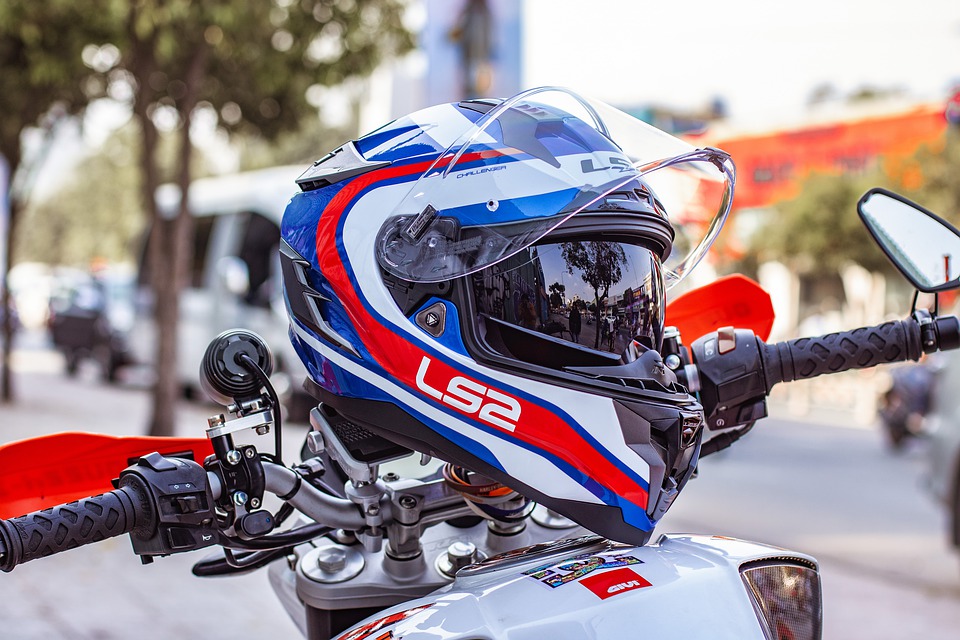
Open-Face or ¾ Helmet
An open-face helmet leaves the face exposed, covering only the top, sides, and back of the head. There is no chin bar or eye protection. This reduces safety, though they do provide adequate protection for the rest of the head.
Tourers and cruisers prefer ¾-helmets as they let the rider feel the wind on their skin. These helmets are lighter than full-face and modular helmets, increasing comfort. Some people prefer them for long rides for this reason.
Half Helmet
This type of helmet covers only the top of the head and provides minimal protection. What attracts riders to them is the airflow, but they don’t have a chin bar or eye protection.
Comparison Overview
Bicycle Helmet vs. Motorcycle Helmet
The biggest difference between a bicycle and a motorcycle helmet is the level of protection. Since bicycles travel at much slower speeds than motorcycles, bicyclists don’t require as much protection.
Pedaling a bicycle up a hill is more demanding than riding a motorcycle up one. In hot weather, a cyclist wearing a full-face helmet does not need any excess weight. The exertion of wearing a heavy helmet while riding could be dangerous for cyclists.
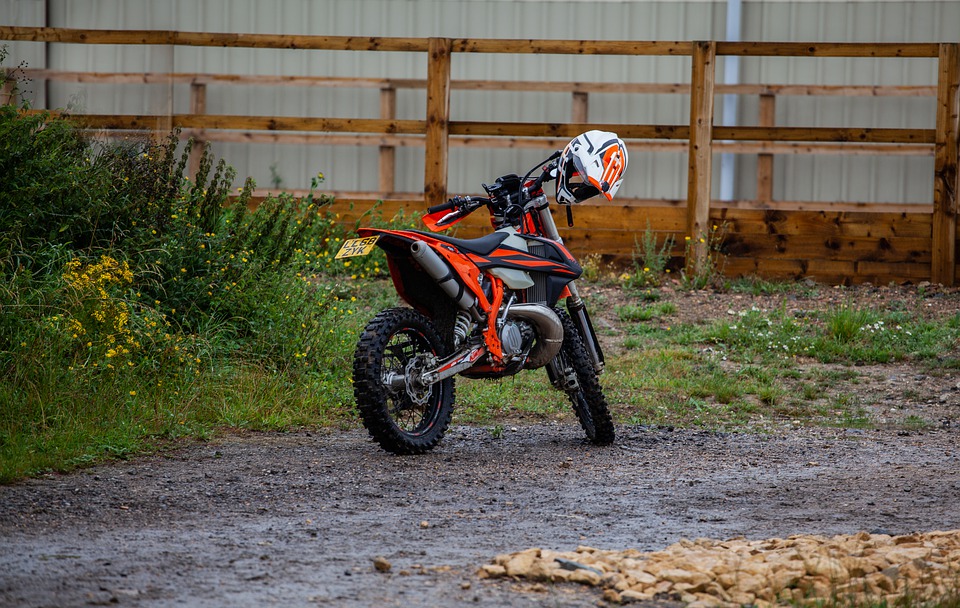
Motorcycle Helmet vs. Car Helmet
In a motorcycle accident, the rider usually falls clear of the bike. In a race car accident, the driver is likely trapped inside the vehicle, which may catch fire. That is why car helmets are fireproof and motorcycle helmets are not.
Motorcycle helmets are far more likely to slide against the pavement. For this reason, they're better protected against abrasion. Car racing helmets may bump into the roll cage or side window, but they’re unlikely to slide against the pavement.
Racing helmets thread into head and neck safety devices. These are in most race cars and prevent the head and neck from jerking too much. Motorcycle helmets don’t have this feature. Riders sit in a completely different position when riding. Plus, they need to be able to move their heads around while on the road.
Cheap vs. Expensive Motorcycle Helmets
The biggest difference between cheap and expensive motorcycle helmets is the material quality. It’s never appropriate to choose the cheapest option. If you’re going to invest in one piece of expensive riding gear, it should be a high-quality helmet.
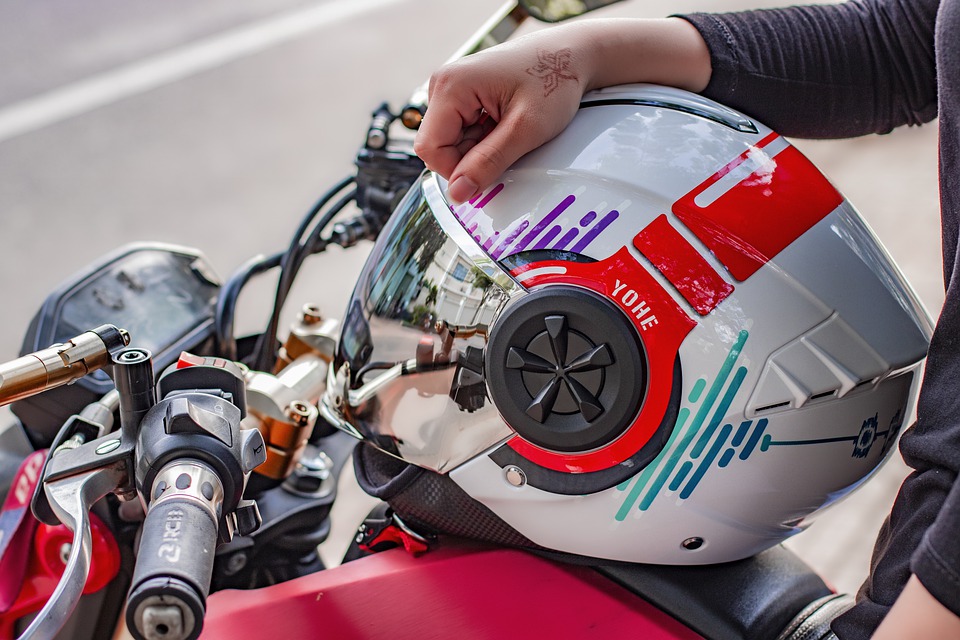
How to Put on a Motorcycle Helmet
Here’s an easy way to put on a motorcycle helmet properly. Be sure to refer to the video below for a quick demonstration of what to do and what not to do.
- Turn the helmet upside down and hold open the straps.
- Place the helmet over your head.
- The straps should now be hanging out of the bottom of the helmet.
How to Strap a Motorcycle Helmet
- Take the right strap and pull it under your chin.
- Thread the right strap through both D-rings.
- Separate the rings and loop the strap back through the first ring.
- Pull the strap to make sure it’s tight enough without being too tight.
How to Clean a Motorcycle Helmet
Wondering how to clean your motorcycle helmet? Here are 14 easy steps to follow. See the video below for a full overview.
- Always consult the owner’s manual first to see if there are any special instructions.
- Collect your supplies: many microfiber rags, a soft bristle toothbrush, and baby shampoo. You will also need a tub of warm water and compressed air to clean the vent system. Never use canned air on your helmet as the aerosols can cause damage.
- Remove any electronic system, like Bluetooth.
- Remove the internal padding.
- Wet a microfiber rag and place it on top of the helmet. Allow it to sit for about 15 minutes to remove anything that’s stuck on.
- Clean the internal padding. Fill a sink with warm water and add a little bit of baby shampoo. Submerge each piece of padding and massage it, then rinse in clean water. Do one piece at a time, then lay them on a towel to dry.
- Remove the wet cloth from the helmet and take off the face shield.
- Use the wet cloth to clean the exterior of the helmet.
- Next, use the toothbrush to get into gaskets, vents, and any other small areas.
- Use the air compressor to dislodge anything stuck inside the vents.
- Dry the helmet with a clean microfiber cloth.
- Move onto the face shield. Use a microfiber rag and water to remove anything that is stuck to the surface. Then, dry with a clean microfiber rag.
- Pull down the internal sun visor and clean any dirt with warm water and a microfiber rag.
- Reassemble the helmet once the internal padding is completely dry.
Conclusion
Though it might be tempting, it’s never a good idea to purchase the cheapest motorcycle helmet you can find. In fact, you should get the best one you can afford. There are many types of helmets to choose from, and we hope we provided you with the information you need to find the ideal fit for you.
People Also Ask
Here are some common questions people have about motorcycle helmets.
How to Paint a Motorcycle Helmet
There are a lot of methods for painting a motorcycle helmet, but here’s one of the easiest. Use painter’s tape to cover any area you want to protect from the paint. Then, use spray paint to cover the helmet. When the paint is dry, cover it in a clear coat.
What Kind of Paint to Use on Motorcycle Helmet?
You should use the best quality paint available to make sure it lasts. Spray paint will work on most helmets, but some composites require acrylic paint.
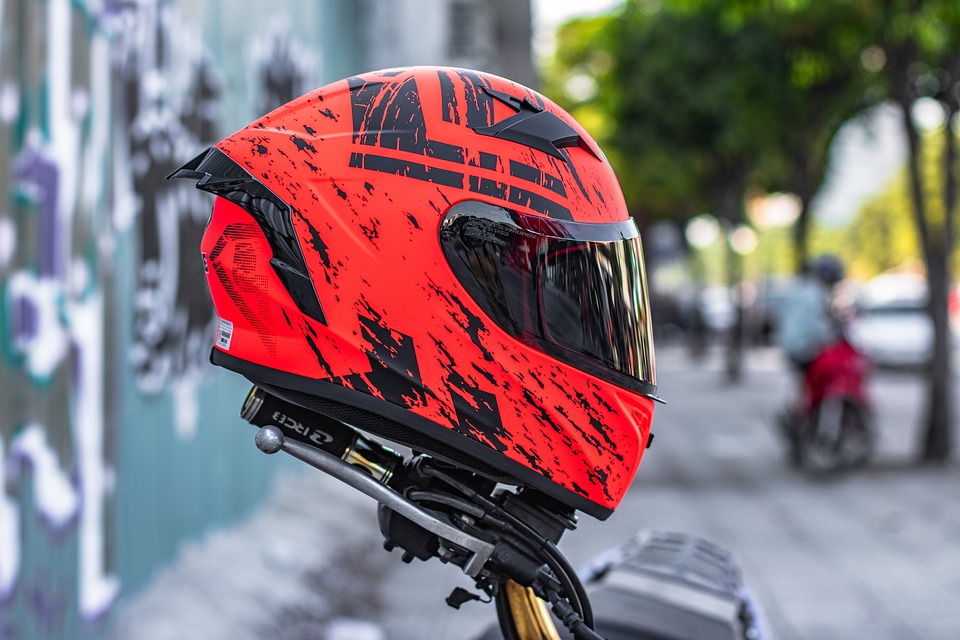
What States Require Motorcycle Helmets?
The following states require all motorcycle riders to wear a helmet: Alabama, California, Georgia, Louisiana, Maryland, Massachusetts, Mississippi, Missouri, Nebraska, Nevada, New Jersey, New York, North Carolina, Oregon, Vermont, Virginia, Washington, West Virginia, and Washington D.C. Other states have age restrictions that apply to riders under the age of 18 or 21.
What to Do With a Motorcycle Helmet When Parked?
Take it with you if you can. Helmets are essential and expensive, and a lot of people aren’t comfortable leaving them with the bike. If you have to leave it behind, invest in a lock to keep it safe and securely attached to your motorcycle.
How Much Are Motorcycle Helmets?
The price range varies drastically, from around $100 upwards of $1000.
How to Make a Motorcycle Helmet Quieter
There is nothing you can do to soundproof a helmet. You can improve the noise level, though. First, make sure your helmet fits properly. Try helmet ear muffs or earplugs or adding a scarf or balaclava around your neck. This prevents air from getting into the bottom of the helmet. Or, adjust the windscreen of the bike to deflect air away from you as you ride.
How Long Do Motorcycle Helmets Last?
Most helmets last about five years, but this varies depending on the quality of the helmet and how much you ride. Look for signs of wear and tear. If you see cracks or if the helmet no longer fits you well, it’s time for a new one.
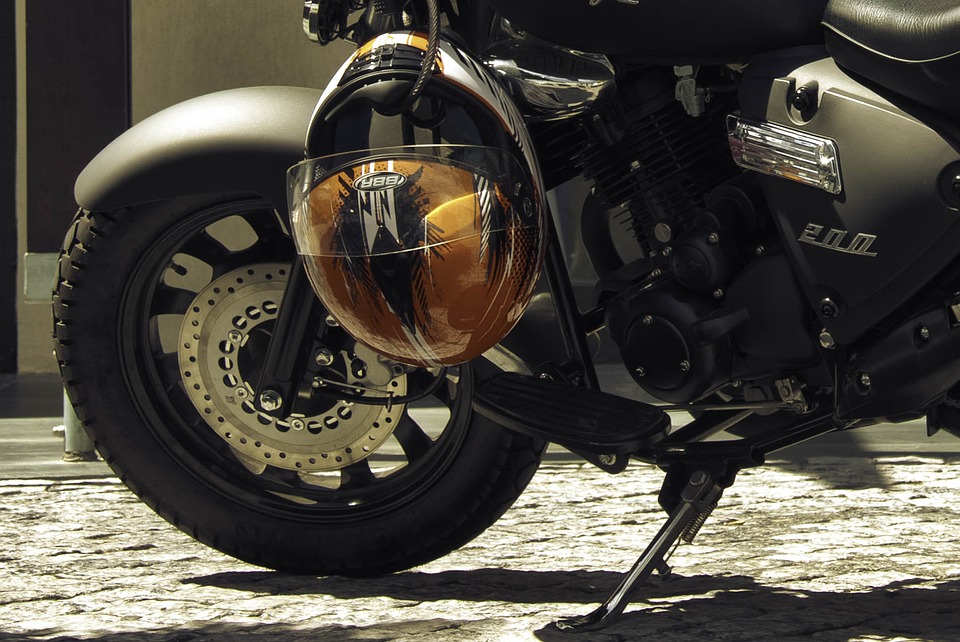
Can I Take the DOT Sticker Off My Helmet?
You don’t have to leave the sticker on the back of the helmet. There is an official DOT sticker on the inside of the helmet as well. That said, all helmets should have a DOT sticker on the back when sold.
What is a DOT Compliant Helmet?
A DOT-compliant helmet meets the safety standards established by the Department of Transportation. The helmet has a thick inner liner, sturdy chin straps, and weighs about three pounds. It should have decorative elements protruding more than 2/10 of an inch.
Does Dropping a Helmet Ruin it?
Dropping a motorcycle helmet once or twice is okay. The danger lies in repeated droppings. If you’re careless and lose track of how many times you dropped it, it could be unsafe.
Why Does My Motorcycle Helmet Hurt My Head?
It might be the wrong size or shape for your head. Cheaper motorcycle helmets use lower quality material. They tend to be more uncomfortable than more pricey ones.

Do Black Motorcycle Helmets Get Hot?
The outside of a black helmet usually gets hotter than a white or light-colored one. This shouldn’t affect the inside of the helmet. Most have vents that keep your head cool. Plus, the air running over the surface of the helmet while riding helps disperse the heat.
Should a Motorcycle Helmet Squeeze Your Cheeks?
The cheek pads should be snug to make sure the helmet stays in place, but it shouldn’t cause pain. Your helmet shouldn’t hurt. If you’re uncomfortable, try adjusting the cheek pads or trying a different shape and size helmet.
Do Motorcycle Helmets Loosen up?
Yes, they do. The padding wears down and conforms to the shape of your head as you wear the helmet, causing it to loosen up over time.
What to Do With an Old Motorcycle Helmet?
There isn’t really a solid answer about what to do with an old helmet. Use it as a decoration. Recycle it into a planter. Some motorcycle shops accept helmet trade-ins. The one thing you should not do is sell an old helmet.
How to Wear Goggles With a Motorcycle Helmet
First, you have to have the right kind of helmet. You don’t need them under a full-face helmet, but they’re ideal for half or ¾ helmets that don’t offer any eye protection. The most important thing to remember is the goggles should never get in the way of the chin strap. They should not affect the fit of the helmet.
Motorcycle Helmet Guides
Looking for all of our guides on motorcycle helmets? You've come to the right place. Here are all of our helmet related guides:
